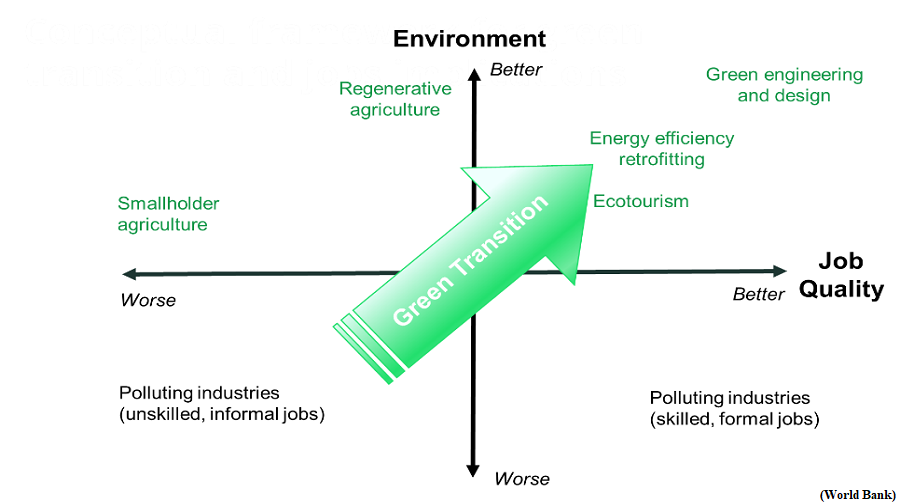Greening the labour market, Sustainable employment in the Global South (GS Paper 3, Economy)

Context:
- Green jobs serve both as a mechanism to achieve sustainable development and as an outcome of policies designed for a just green transition. They also catalyse the much-needed economic transitions to address the challenges of climate change.
- Climate change is reshaping economies and societies globally. Among its significant impacts is the transformation of labour markets.
Potential:
- The intersection of climate change policies and employment dynamics is a pressing concern, particularly in the context of the Global South with its unique challenges.
- The International Labour Organisation (ILO) estimates green transitions generating over 100 million jobs by 2030, “that fully takes into account their social dimensions”.
- The Skill Council for Green Jobs claims that India has the potential to create 35 million green jobs by 2047.
Defining “green jobs”
- Defining green jobs is a complex challenge due to the various activities involved in promoting environmental sustainability. These actions span from reducing pollution and conserving resources to improving energy efficiency.
- The ILO defines green jobs as ‘decent’ and environmentally responsible roles that contribute to preserving or restoring the environment.
- Another approach, favoured by the United Nations Environment Programme (UNEP), adopts a sectoral and occupational approach in order to capture the direct contributions of certain jobs to environmental preservation and restoration in specific sectors like waste management and renewable energy.
- Another perspective looks at manufacturing and production processes. For instance, the European Union and the United States identify workers producing solar energy systems, biofuels, or electric vehicles as green workers. This viewpoint assesses the environmental impact of final products, moving beyond sector-specific considerations.
- Regardless of the approach taken, it’s crucial to consider factors like equality, safety, and wages when defining green jobs.
Labour market implications:
- Green transition policies will impact the labour market through three dimensions:
- The changing consumer habits due to a growing demand for cleaner products could lead to sectoral expansions or contractions.
- They directly affect natural and built environments, impacting workforce availability, particularly in agriculture-dependent regions, and increase the vulnerabilities of industries, such as tourism, insurance, forestry, fisheries, infrastructure, and energy.
- The regulatory frameworks addressing climate change can help generate jobs in climate adaptation-related sectors, such as investments in disaster-resilient infrastructure and coastal defences. However, the net job creation effects are complex, hinging on factors like public spending and trade-offs with other economic activities.
- As the world creates green jobs, the above three dimensions will substitute jobs with high emissions, and lead to the loss of environmentally-unsustainable jobs.
- These implications on the labour market, however, are projected to keep all other variables of technological advancements and geographical restrictions constant.
Strategic pathways:
- The narrow scope and coherence in defining green jobs have elicited unfavourable conditions for the Global South.
A Global South-specific taxonomy:
- While there is consensus on the need to focus on mitigation policies for climate resilience, adaptation is necessary to address the social dimension of employment. This adaptation can be achieved by skilling the labour force for green jobs and a redefining the green taxonomy for the Global South.
- A Global South-specific green taxonomy will contribute to effective resource utilisation for reduced emissions. It will also increase employment opportunities in sectors based on sustainable resource management and protection.
- It would channelise targeted investments for the creation of green sectors and jobs through formalisation.
Planning for a Just Transition:
- A just transition depends on the reintegration of workers put out of work due to decarbonising of economies around the world.
- The International Monetary Fund suggests that high-skilled and urban workers tend to have more green-intensive occupations than lower-skilled rural workers.
- Achieving policy coherence therefore demands collaborative partnerships between development sector firms and governments, localised to facilitate the integration process.
- A just transition necessitates focusing on future-oriented skills development, institution building, and enhancing capacity.
South-South Cooperation:
- South-South cooperation offers a dynamic avenue for nurturing green labour markets and fostering green job creation, as illustrated by numerous real-world cases.
- Collaborative endeavours between nations like India, Brazil, and China have facilitated the exchange of expertise in renewable energy, sustainable agriculture, and eco-tourism.
- While the ambit of many current dialogues is limited to green recovery and financing, these interactions exemplify the potential of knowledge-sharing to not only environmentally transform industries but also generate green employment opportunities.
- Such cooperative ventures capitalise on shared experiences and collective efforts, reinforcing the trajectory towards more sustainable labour markets.
Conclusion:
- Achieving a greener economy does not automatically ensure inclusivity and social sustainability, especially from a Global South perspective.
- Complementary labour market policies and factoring in unique local socio-economic particularities are needed to mitigate risks and achieve meaningful transition.
- Policy coordination, proactive planning, and targeted skill development are crucial for successfully integrating the Global South into the green economy.
- Instrumentalising a green framework that responds to the economic and labour systems of the Global South can unlock the real potential for green employment generation to effectively reintegrate surplus labour in the market.


